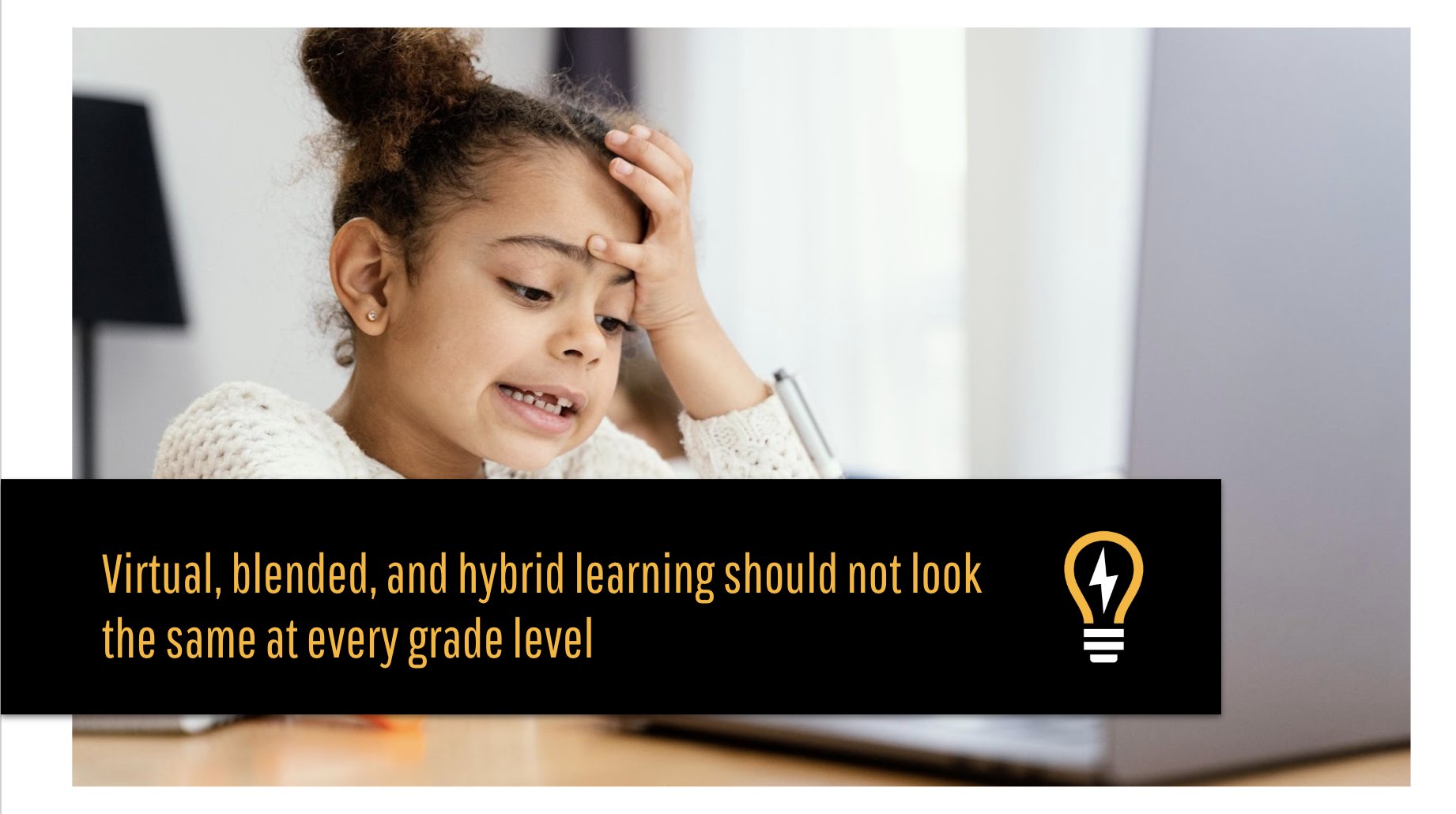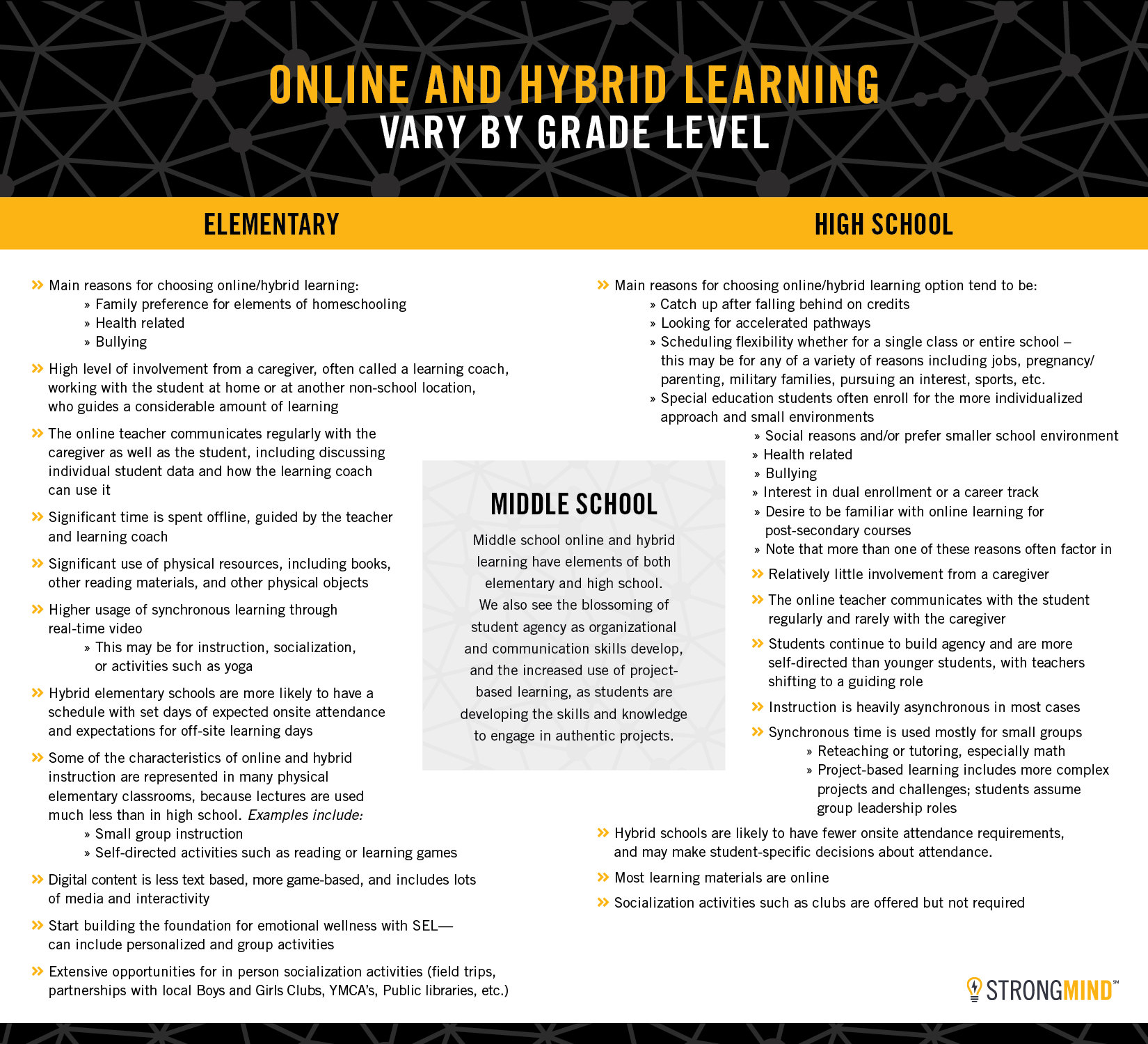Although primary and secondary education is often combined as “K-12,” everyone recognizes that second graders are very different from high school students. That said, how can we shift conversations regarding instructional strategies and policies to focus on the different ways online and hybrid learning can serve students of all ages?
This document and the associated graphic detail a few of these differences. We focus on comparing elementary and high school, recognizing that middle school students fall in the middle on many of these issues. Also, we note that all statements below are general characterizations and exceptions apply.
Missed our recent webinar on this topic? Watch the recording here!
Characteristics of elementary school students in online/hybrid learning
When many people hear the term “online learning” they picture a student in front of a computer, possibly working alone, or talking with a teacher or classmate. They are also likely to picture a high school or college student.
Hundreds of thousands of K-5 students have successfully completed online elementary school courses and advanced to middle school. Their experience is not quite the same as is often imagined of high school students, for several reasons.

First, the online teacher leans heavily on a caregiver who works with the student in the student’s home or another location. The caregiver, often called a learning coach, helps the student stay on task, navigate the school technology platform, and alternate between online and offline activities. The number of offline educational activities for the youngest students is also much higher than for older students. Young students may read paper books, fill out pencil-and-paper workbooks, and work with basic physical manipulatives and materials. There is relatively less use of digital content, and that content is more game-based and includes lots of media and interactivity. It may even have cartoon characters directing students through the content.
Elementary age students are also, obviously, making choices that are guided heavily—if not entirely—by their caregivers. They may be in an online or hybrid school for reasons related to family preferences for elements of homeschools, for health-related reasons, or because of bullying or other social issues.
Hybrid elementary schools are likely to have a schedule with set days of expected onsite attendance and expectations for off-site learning days. During the onsite days, a hybrid elementary school may look much like a traditional elementary school, with extensive small-group instruction and activities.
Full-time online schools tend to stress socialization activities for elementary students, including field trips, partnerships with local YMCAs, Boys and Girls Clubs, public libraries, holiday parties, etc.
Characteristics of high school students in online/hybrid learning

The main difference between elementary age students and high school students is that high school students are more technologically adept and more able to work on their own. This means that high school students spend more time online, and they communicate with their teacher through a variety of means. A caregiver/learning coach may still be involved, but much more in the background compared to elementary school students.
High school students are likely to be choosing an online or hybrid school for the flexibility that the school provides, or because the student wants to make up classes or get ahead. The ability to work at the student’s own pace is therefore critical in most cases, as is the option to prioritize the time for pursuits which may include jobs, internships, supporting a family, arts, sports, or other interests.
Hybrid high schools are unlikely to have a schedule with set days of expected onsite attendance. Instead, the onsite time may be as little as one hour per week, or it may be based on a minimum number of hours which fluctuate each week based on a teacher or counselor’s assessment. During the onsite times, students are likely to be tutored one-on-one or work in small groups.
Some schools prioritize project-based learning, because high school students are able to engage in authentic projects. These projects may be linked to a job, internship, or post-secondary activity.
Characteristics of middle school students in online/hybrid learning
Middle school online and hybrid learning have elements of both elementary and high school. Sixth grade is, of course, more like elementary, and eighth grade more like high school. We also see the blossoming of student agency as organizational and communication skills develop, and the increased use of project-based learning, as students are developing the skills and knowledge to engage in authentic projects.
For a full list of the characteristics of online and hybrid learning at elementary, middle, and high school levels, see the table below:







